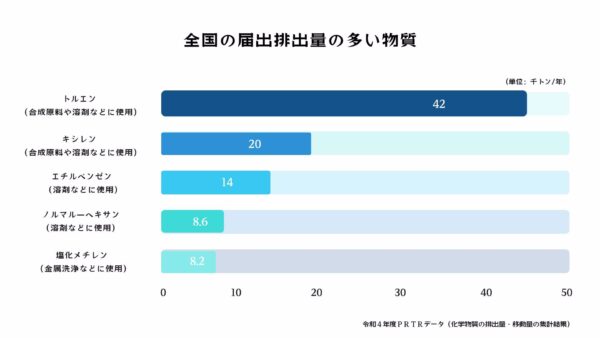SUSTAINABILITY NEWS
“Substances with the highest notifiable emissions in Japan”

BTX-free is defined as three volatile organic compounds ( VOCs).
These chemicals are commonly found in industrial products such as paints and adhesives and release volatile organic compounds, which can have a negative impact on the environment and worker health. BTX-free products do not contain these harmful substances or contain very small amounts, making them a safer and more environmentally friendly option.
The BTX-free movement has become the modern standard, supported by sustainable manufacturing and health-conscious consumers, with an emphasis on product safety and environmental friendliness.
WHY DO WE NEED TO PROMOTE BTX-FREE ?
In recent years, awareness of environmental issues has increased around the world, and BTX-free has become a standard initiative aimed at protecting the environment and taking care of health. In addition, laws and regulations continue to tighten in various countries, and consumers are increasingly adding environmental considerations in the manufacturing process to their purchasing motivations. That’s why companies and manufacturers are actively promoting this.
Effects on health
Benzene, toluene and xylene are volatile organic compounds that can have adverse health effects if exposed to them for long periods of time or in high concentrations. In particular, workers who come into contact with these chemicals in the manufacturing industry are at high risk, so appropriate measures are required to minimize health risks.


Environmental impact
BTX compounds are released into the atmosphere and are involved in the production of ozone and organic compounds, which can contribute to photochemical smog and global warming. It can also migrate into water and soil, causing water and soil contamination. In order to minimize the negative impact on the environment, the development and use of BTX-free products is actively promoted
Laws and Regulatory Requirements
BTX compounds are regulated in many countries around the world and must comply with environmental standards and occupational health and safety regulations. As such, BTX-free is an important way to meet these regulatory requirements. /b13>By going BTX-free, companies can ensure legal compliance while providing products that are friendly to the human body and the environment.

Do you know? The effect of BTX solvent on the body
BTX solvent is a mixture of benzene, toluene, and xylene. These chemicals are widely used in industrial products, paints, solvents, adhesives, etc., but prolonged exposure and high concentrations of contact without proper measures can cause adverse health effects.

Benzene
Long-term exposure can cause blood and bone marrow abnormalities, such as myelodysplastic syndromes and acute myeloid leukemia. In acute exposure, symptoms of intoxication may appear, such as headache, dizziness, nausea, and loss of consciousness

Toluene
It has effects on the central nervous system and can cause symptoms such as dizziness, headache, nausea, fatigue, and insomnia. With long-term exposure, it can adversely affect the liver and kidneys.

Xylene
In acute exposure, symptoms of intoxication may appear, such as headache, dizziness, nausea and vomiting. With long-term exposure, it can adversely affect the liver and kidneys.
Ranked among the top "Substances with the highest notifiable emissions in Japan"
Looking at the PRTR data for FY4 Reiwa (aggregate results of chemical substance emissions and transfers), BTX is ranked among the top substances with the highest notifiable emissions nationwide.
(Reference: Ministry of Economy, Environment press release). In particular, toluene and xylene are highly important as synthetic raw materials and solvents, and their use has been shown to be large. Ethylbenzene also plays an important role as a solvent. On the other hand, these chemicals can have a negative impact on the environment and health, so safe handling and emission management are important. There is a need for the development of environmentally and health-friendly products and the use of alternative substances.

BTX-free, environmentally-friendly paint
Musashi Paint's long-time bestseller [Eco Haiurex P Series] is a two-component acrylic urethane paint for environmentally friendly plastics that does not contain benzene, toluene, or xylene. * You can see the materials for the following three types of paints.

Achieves a wide variety of solid colors (EC-P79)

High-brightness metallic paint, color 1 Can be expressed in court(EC-GPX79)





